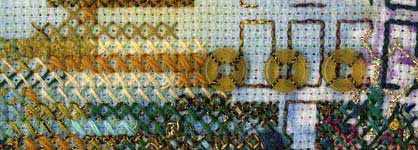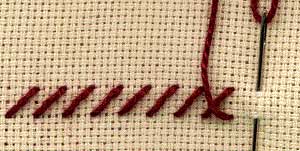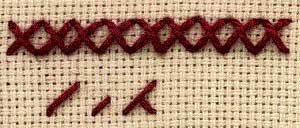Cross Stitch

![]() Cross stitch, which is also known as sampler stitch, Berlin stitch and point de marque, is currently very popular due to a huge industry in designs and kits. I am sure historians of the future will speak about late twentieth and early twenty first century cross stitch as they speak of Berlin wool work of the Victorian era. They will either love it or be dismayed by its popularity! Nevertheless it is one of the oldest stitches in the history of textiles and used world wide today as in the past.
Cross stitch, which is also known as sampler stitch, Berlin stitch and point de marque, is currently very popular due to a huge industry in designs and kits. I am sure historians of the future will speak about late twentieth and early twenty first century cross stitch as they speak of Berlin wool work of the Victorian era. They will either love it or be dismayed by its popularity! Nevertheless it is one of the oldest stitches in the history of textiles and used world wide today as in the past.

Cross stitch can be worked individually completing each cross before moving on to the next. This is a useful way to work if you are using multicoloured thread. To work cross stitch in rows work a line of diagonals in one direction and then on the return journey work the top diagonals as illustrated.

Cross stitch in its simplest form is made by two bisecting diagonal stitches. It is extremely quick and easy to work usually on even weave fabrics.
Although the actual construction of cross stitch is the same there are different ways of working. One rule remains constant, and that is, that the top diagonals should always lie in the same direction.
This rule however, is broken by some contemporary embroidery if a deliberate effect is desired in which case the top diagonals will vary in order to catch the light in a particular direction or simply to break up the even surface.
Half and Quarter cross stitch
As illustrated half cross stitch and quarter cross stitch is just that. Half a cross stitch or a quarter of the stitch worked where it is required to smooth out the jagged edges of a design.

Cross Stitch Family.
Cross stitch is based on the simple action of crossing one thread against the other. This action in stitching has been used around the globe since the beginning of textile history. For this reason, there are many variations to Cross stitch and some listed here. They are Alternating cross stitch, Rice stitch, Double cross stitch, Long arm cross stitch and Montenegrin. There are many more I just have not got around to listing them yet!
